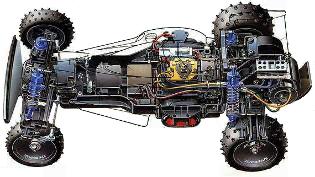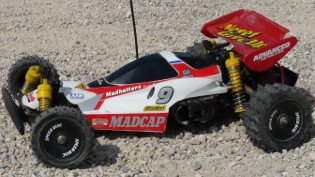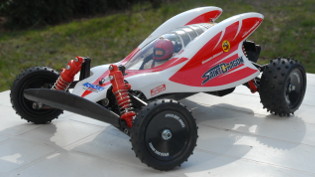The Astute platform
This platform has no official name and fans did not give it one either: again, the name of the first model of the series will serve. This is Tamiya's first modern race-oriented 2WD buggy platform and it counts 3 variants:
- race-oriented buggies
- leisure-oriented buggies
- Stadium Trucks
Undoubtedly, this platform is part of the strategy initiated with the Avante, that is a more modern, more serious series, with model names no longer inspired by animals and more conventional bodyshells.
58080 Astute (1989)
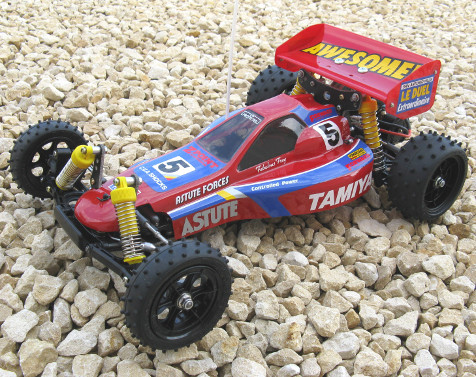
58097 Super Astute (1991)
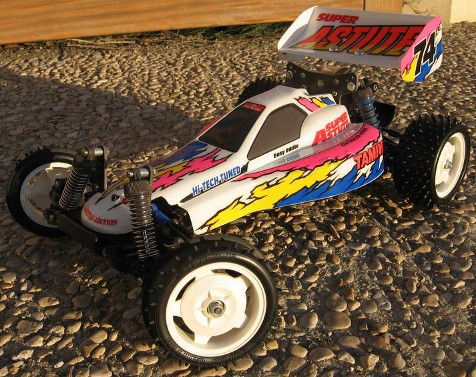
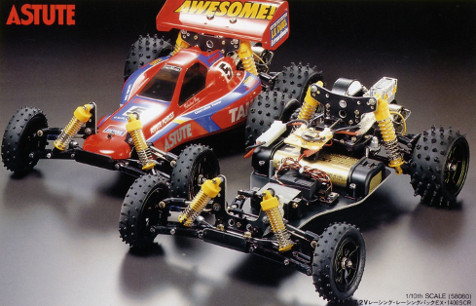
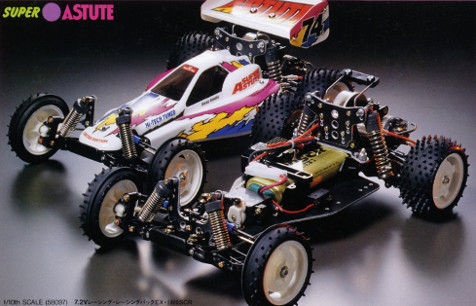
Everything is the Astute proves this buggy was designed for serious racing. Unfortunately, it carries some of the Avante flaws, especially this feeling of “too much”: too complicated, over-engineered. The Astute main design flaw is at the front: as per logic with a 2WD buggy, Tamiya placed as many weight at the rear of the chassis in order to optimize traction. The consequence is a very light front drivetrain struggling for grip, what is called heavy understeer. Despite this, the Astute will sell well and will be much appreciated by club racers. Jamie Booth will even win the 1991 European Championship with a modified (simplified) Astute, but this win will remain the only significant one for the buggy.
2 years later, the Super Astute will be released, bringing modifications to remedy the Astute flaws: namely, the battery pack was relocated longitudinally, solving the understeer flaw. In addition, it was made more reliable (especially the transmission) and simpler. Above all, the Super Astute introduced the TTC (Tamiya Traction Control), some sort of equivalent to the “slipper” Associated introduced with their RC10 in 1990. The Super Astute is the “ultimate” Astute: the model will sell well and will be much appreciated by club racers too.
Like the Vanquish compared to the Avante, Tamiya offered more general public and more economic versions to the Astute with the Madcap and Saint Dragon.
The Madcap is a pretty good model to start with in club racing, as long as you upgrade it (dampers and ball bearings). Unfortunately, the transmission has the same reliability problems as the Astute's. Technically, the Saint Dragon is identical to the Madcap, only the bodyshell and dampers color changed: however, the Saint Dragon did not sell well in Europe and USA because of the “manga” bodyshell, the exact opposite of what happened in Japan and most Asian countries due to the manga craze of the late 80's. The Saint Dragon bodyshell style is shared with the Thunder Dragon and Fire Dragon we reviewed before.
At the same period, Tamiya fits the Astute gearbox and arms to a bathtub chassis, creating a Stadium Truck variant for a new popular category in USA at the time.
58081 Nissan King Cab (1989)
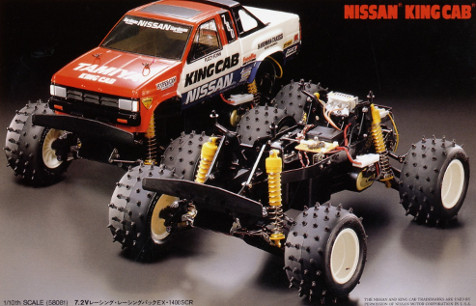
58086 Toyota Hilux Monster Racer (1990)
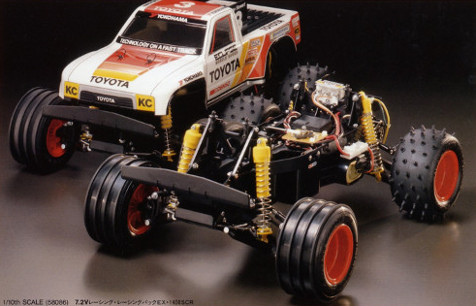
The King Cab and Monster Hilux were considered as references in the period Stadium Truck category and they were much appreciated by racers despite the gearbox reliability, problems that were quite more frequent due to the bigger wheels.
There was a lesser-known Astute evolution. In fact, it is a specific development from the TRF Team using the Super Astute as a basis. The prototype that came out at the beginning of 1992 was called TRF211X:
- Super Astute suspension
- Super Astute chassis geometry
- entirely new transmission
- new dampers
- chassis in carbon
The TRF211X will never be sold but it will give birth to the 58116 Dyna Storm and 58123 Dyna Blaster. These two models will mostly be TRF211Xs, except some material replaced due to cost reasons. Also, the Dyna Storm will keep the TRF211X bodyshell shape.
TRF211X chassis
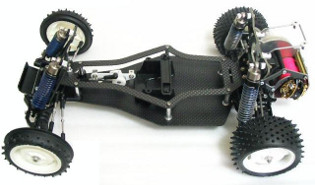
Dyna Storm chassis
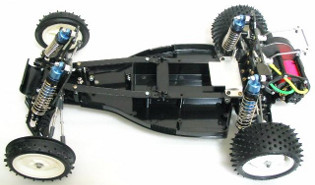
Dyna Storm gearbox
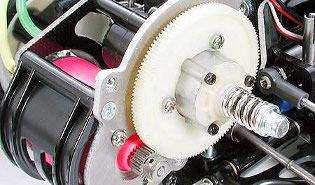
58116 Dyna Storm (1992)
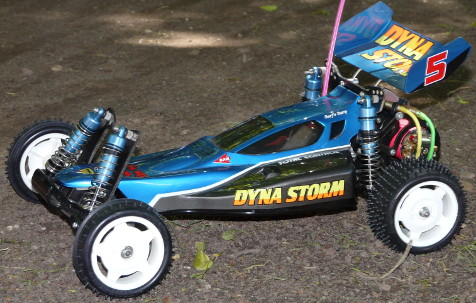
The Dyna Storm was quite successful among club racers due to its good chassis balance, its excellent suspension greatly help by the Sleeved Dampers and a well-performing and reliable transmission. Unfortunately, some parts of the chassis were fragile and altered the buggy overall reliability.
The Dyna Storm also had its Stadium variant, in fact two, one electric with the Dyna Blaster and one gas-powered with the TR-15T:
58123 Dyna Blaster (1993)
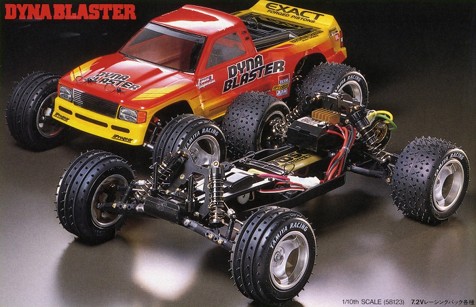
44001 Stadium Racing Truck TR-15T (1993)
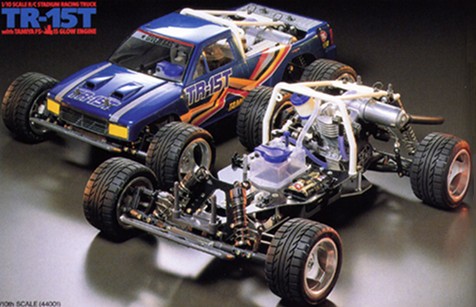
The Dyna blaster had not as much success as the Astute-based Stadium Trucks, mostly due to its overall chassis fragility and cost. This symptom affected the TR-15T too, one of the first gas-powered Stadium Truck to hit the market.
Conclusion on the Astute platform
Strategically, the Astute platform was as important as the Avante platform was for Tamiya, in relative terms since the off-road 2WD buggy market was less prestigious than the 4WD buggy market. Nonetheless, Tamiya's strategy with the Astute aimed the same goals the Avante did: to reach the highest ranks in international racing. Here too, Tamiya failed to achieve their goal, but results were better than with the Avante because Astutes and Super Astutes were often run at club level races. On the economic level, results were better than the Avante platform because the Madcap and Saint Dragon were successful, as well as the Stadium Truck variants that even became much appreciated models at their time for racers.
With the Astute platform, Tamiya shows again their firm intentions at serious racing. Like with the Avante, Tamiya massively invested to reach that goal, but even if results were not fully achieved, this program was not a complete fail at all. Industrially and economically, the Astute platform was more rational than the Avante since, among other aspects, it was possible to use it on three different market segments.
Related articles:




